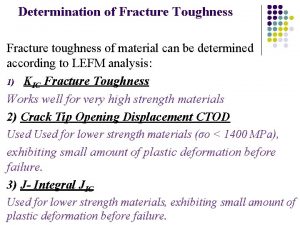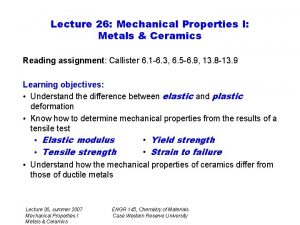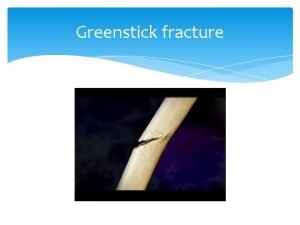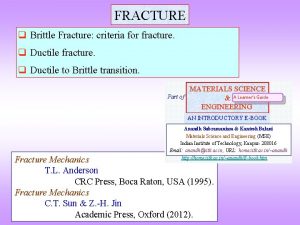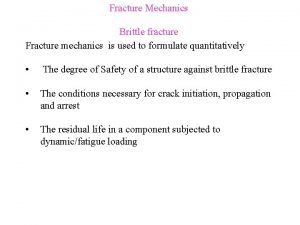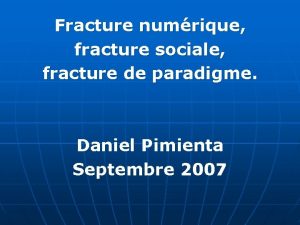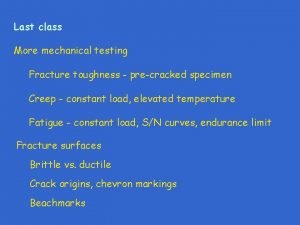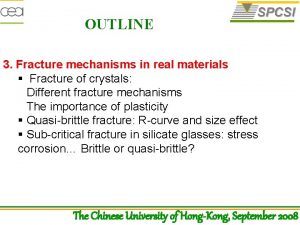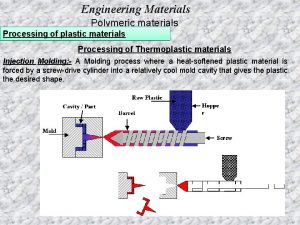FRACTURE and TOUGHNESS DESIGN Materials engineering science processing




















- Slides: 20

FRACTURE and TOUGHNESS DESIGN Materials: engineering, science, processing and design

Strength Resistance of a material to plastic flow Toughness Resistance of a material to the propagation of a crack Materials: engineering, science, processing and design

This type of test provides a comparison of the toughness of materials However, it does not provide a way to express toughness as a material property Materials: engineering, science, processing and design

Remote stress applied to a cracked material The local stress is proportional to the number of lines of force which rises steeply as the crack tip is approach Materials: engineering, science, processing and design

Cracks concentrate stress At the tip of a crack the stress can be very high: Metals: the zone near the crack tip is plastic Ceramics: the zone near the crack tip has micro-cracks Composites: near the crack tip, delamination and debonding Materials: engineering, science, processing and design

Cracks propagate when the stress intensity factor exceeds a critical value The critical value is known as the fracture toughness K 1 c Materials: engineering, science, processing and design

A plastic zone forms at the crack tip where the stress would otherwise exceed the yield strength Materials: engineering, science, processing and design

A material transitions from yield to fracture at a critical crack length Materials: engineering, science, processing and design

Critical crack lengths are a measure of the damage tolerance of a material Tough metals are able to contain large cracks but still yield in a predictable, ductile manner Materials: engineering, science, processing and design

Values range from 0. 01 – 100 MPa√m Contours show the toughness, Gc Materials: engineering, science, processing and design

Transition crack length plotted on chart Values can range from near-atomic dimensions for ceramics to almost a meter for ductile metals Materials: engineering, science, processing and design

Characteristic of ceramics and glasses Local stress rises as 1/√r toward the crack tip If it exceeds that required to break inter-atomic bonds, they separate, giving a cleavage fracture Materials: engineering, science, processing and design

Materials contain inclusions which act as stress concentrations when loaded The inclusions separate from the matrix causing voids to nucleate and grow, causing fracture Materials: engineering, science, processing and design

If a material is ductile, a plastic zone forms at the crack tip Within the plastic zone, voids nucleate, join, and link to cause fracture The plasticity blunts the crack tip, reducing the severity of the stress concentration Materials: engineering, science, processing and design

At low temperatures some metals and all polymers become brittle As temperatures decrease, yield strengths of most materials increase, leading to a reduction in the plastic zone size Only metals with an FCC structure remain ductile at the lowest temperature Materials: engineering, science, processing and design

Impurities in an alloy are normally found in grain boundaries This leads to a network of low-toughness paths that can lead to brittle fracture Materials: engineering, science, processing and design

Increasing the yield strength of a metal decreases the size of the plastic zone surrounding a crack This leads to decreased toughness Materials: engineering, science, processing and design

Fillers, impact modifiers, and fiber reinforcement can significantly alter the fracture toughness of polymers Materials: engineering, science, processing and design

When a crack grows in a matrix, the fibers remain intact and bridge the crack Materials: engineering, science, processing and design

SUMMARY Toughness is resistance to the propagation of a crack Tough materials yield rather than fracture Toughness is a material property By choosing materials with sufficient toughness, design can be immune to small cracks Many metals and some composites are tough “enough” for this kind of design Polymers and ceramics are not tough enough in most cases Materials: engineering, science, processing and design
 Materials: engineering, science, processing and design
Materials: engineering, science, processing and design Fracture toughness
Fracture toughness Eacads iitd
Eacads iitd Example of ductile fracture
Example of ductile fracture Strain energy formula
Strain energy formula Elastic range
Elastic range Workshop test for toughness
Workshop test for toughness Modulus of resilience
Modulus of resilience Elastic compliance
Elastic compliance Sas mental toughness
Sas mental toughness My favorite subject is math and english
My favorite subject is math and english Cant stop the feeling go noodle
Cant stop the feeling go noodle Useful and harmful household materials
Useful and harmful household materials Natural man made
Natural man made Adopting and adapting teaching materials
Adopting and adapting teaching materials Point processing operations
Point processing operations Primary processing of wheat
Primary processing of wheat Batch processing vs interactive processing
Batch processing vs interactive processing Direct materials budget with multiple materials
Direct materials budget with multiple materials Recycling involves taking used materials
Recycling involves taking used materials Natural science matter and materials
Natural science matter and materials

